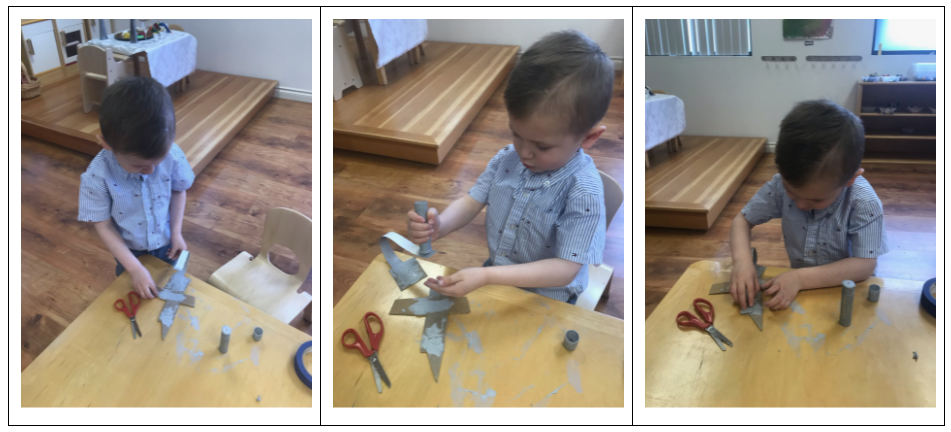How Preschool Children Learn Through Play
Gan Blog, May 2021 Part 2 of the series: What children learn through free play.
At the Gan-Garrett Jewish Preschool, we provide several time periods each day for the children to have unstructured, self-directed play, which research shows is essential for healthy development in all learning domain areas. This Blog series is designed to show just some of the concepts, principles, knowledge and skills that the children gain during “free play.”
Hugo, 3 years old: planning, designing, experimenting, analyzing, thinking, remembering and recalling from memory, adjusting, configuring and reconfiguring,..to reach an end goal.

Hugo told me he wanted to make a jet. He went to the cardboard bin and spent time choosing his pieces. He also chose 2 craft sticks, the silver/gray paint stick, tape and scissors, set them on a table and began to create. He taped the craft sticks in an X shape, cut out tape and taped them together. (This is out of view in these pictures, but will be seen at the end). With only an image of a jet in his mind from memory, he began to form his jet. Hugo covered the pieces of cardboard with the paint, and then stuck the shorter, wider piece of cardboard onto the longer piece, perpendicular to the longer piece. He had a body and wings. He wanted an engine. Hugo painted a piece of long, thin, flimsy cardboard, and curled it up to make a loop. He tried to attach it to his jet, over a wing, with just the sticky paint, as he had when attaching the wings to the body; it uncurled, and fell off.

Hugo looked at it for a few seconds, then cut a couple of pieces of tape, curled the cardboard back on to the jet, and, holding it down, taped it, in 2 places: in the middle of the loop, securing it to the bottom of the jet, and on top of the loop, securing it to the top of the jet. He had created an engine and it held firm, on a wing. Hugo then attached the craft sticks to his jet with tape. With this tail in place, he had finished his jet. He was incredibly proud!
What did Hugo learn? What skills were developing?
Cognitive skills:
Memory and ability to recall from memory: There were no pictures or books or toys in our room, representing jets. Hugo relied solely on memory.
Spatial skills: Which materials would fit the size and shape of the parts of the jet?
Engineering and design: it does indeed resemble a jet; Hugo used these principles when designing. Abstract thought and the ability to visualize all the dimensions of a jet came in to this.
Logic and analysis: What materials could he use to secure the parts together, so he could actually “fly” it around the room without it falling apart?
Social/Emotional skills:
Flexibility: When one method of attaching his engine didn’t work, he immediately tried something else, instead of trying the same method over and over.
Persistence: Hugo didn’t give up when his first engine design failed; he tried again.
Self-direction: The ability to manage his tasks without being directed by anyone else. (This also includes Morahs waiting until the project is finished (uninterrupted free play) before asking him to talk about or describe what he’s doing, but being present and aware, in case help is needed).
Fine motor skills:
Cutting with scissors.
The ability to hold the curled cardboard with one hand while securing it to the jet with tape with the other hand (not as easy for a 3 year old as for an adult).
Language and communication skills:
Vocabulary: naming the parts of the jet.
Engaging in back and forth conversation, and describing his process to me, when he had finished.
Conclusion: This project required time, choice of materials, space to work and the confidence that he could freely explore and create, in order for Hugo to realize his goal. We, as Morahs, encourage the development of all these skills, and, when needed, we give direct instruction to children who are at the beginning stages of learning multi-step procedures or are new to the room, routine, and materials. When given time, materials, and opportunities to explore, make choices, and try, fail, and try again, children develop independence in meeting their needs as they grow, learn and thrive in our environment. We do have Circle Times, and group activities and projects, which are also essential to children’s development in other ways. But it is only during times of unstructured free play when children can realize their own potential for thinking, planning, creating, analyzing, configuring and reconfiguring, to realize their goals.


